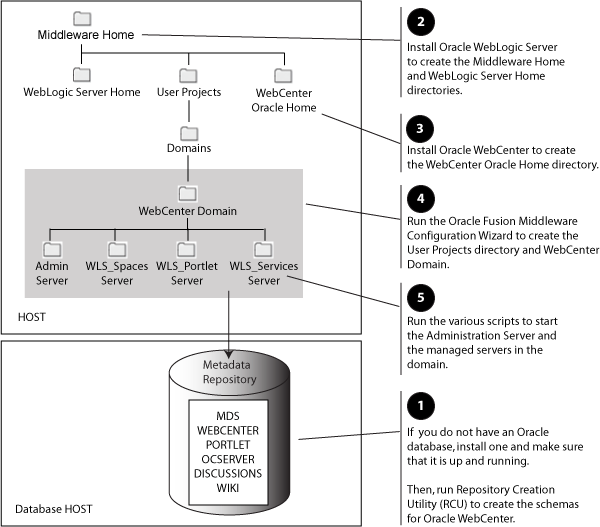1 Installation Overview
Oracle WebCenter is a middleware component of Oracle Fusion Middleware. Oracle WebCenter is a set of products that you use to create social applications, enterprise portals, composite applications, and Internet/Intranet web sites. Oracle WebCenter combines the standards-based, declarative development of Java Server Faces (JSF), the flexibility and power of portals, and a set of integrated WebCenter Web 2.0 Services to boost end-user productivity.
The chapter includes the following sections:
1.1 Oracle WebCenter Components
Oracle WebCenter contains the following components:
-
Oracle WebCenter Framework
Enables you to embed portlets, content, and customizable components into your WebCenter applications. Oracle WebCenter Framework is automatically installed when you install Oracle WebCenter.
-
Oracle WebCenter Spaces
Offers a single, integrated, web-based environment for social networking, communication, and personal productivity through a robust set of services and applications. It is optional to configure this component.
-
Oracle WebCenter Portlets
Supports deployment and execution of both standards-based portlets (JSR 168 and WSRP 1.0 and 2.0) and traditional Oracle PDK-Java based portlets. It includes the following preconfigured portlet producers: OmniPortlet, Web Clipping, Rich Text Portlet, WSRP Parameter Form Portlet, sample WSRP portlet producers, and sample PDK-Java portlet producers. It is optional to configure this component.
-
Oracle WebCenter Discussions
Enables you to integrate discussion forums and announcements into your WebCenter applications. It is optional to configure this component.
-
Oracle WebCenter Wiki and Blog Server
Enables you to integrate wikis and blogs into your WebCenter applications. It also supports features that enable application users to create their own wikis and blogs. It is optional to configure this component.
-
Oracle Content Server
Provides a flexible, secure, centralized, web-based repository that manages all phases of the content life cycle: from creation and approval to publishing, searching, expiration, and archival or disposition.
1.2 Oracle WebCenter Installation Roadmap
Table 1-1 describes the high-level tasks for installing and configuring Oracle WebCenter. The table also provides information on where to get more details on each task.
Table 1-1 Oracle WebCenter Installation Procedure
| Task | Description | Documentation | Mandatory/Optional? |
|---|---|---|---|
|
Task 1 - Complete the installation planning requirements |
Ensure that your system environment meets the general installation requirements for Oracle Fusion Middleware, Oracle WebCenter and Repository Creation Utility (RCU). |
For system requirements information, go to: http://www.oracle.com/technology/software/products/ias/files/fusion_requirements.htm For certification information, go to: http://www.oracle.com/technology/software/products/ias/files/fusion_certification.html |
Mandatory |
|
Task 2 - Create WebCenter schemas |
Oracle WebCenter components require schemas that must be installed in an Oracle database. Prepare an Oracle database for WebCenter schemas and use the RCU to create schemas. |
Make sure you have a supported Oracle database up and running. For more information, see the following OTN link:
For information about creating schemas, see Section 2.1.3, "Create Schemas for Oracle WebCenter." You can also refer to Oracle Fusion Middleware Repository Creation Utility User's Guide. |
Mandatory |
|
Task 3 - Install Oracle WebLogic Server |
Oracle WebCenter 11 The installer creates the WebLogic Server Home directory within the Middleware Home directory. |
For information about installation instructions, see Section 2.1.4, "Install Oracle WebLogic Server and Create the Middleware Home." You can also refer to the Oracle WebLogic Server Installation Guide. For more information about the Middleware Home and WebLogic Server Home directories, see "Middleware Home and WebLogic Home Directories" in the Oracle Fusion Middleware Installation Planning Guide. |
Mandatory |
|
Task 4 - Install Oracle WebCenter |
Use the WebCenter installer to install Oracle WebCenter. Within the Middleware Home directory, by default the installer creates the directory named The installer lays down the WebCenter binaries for various products, including WebCenter Spaces, Oracle WebCenter Portlets, Oracle WebCenter Discussions, Oracle WebCenter Wiki and Blog Server, and Oracle Content Server. |
For information, see Chapter 2, "Installing Oracle WebCenter." |
Mandatory |
|
Task 5 - Configure Oracle WebCenter |
Create and configure a new WebLogic domain for Oracle WebCenter and choose the products that you want to install. The installer creates a domain, which contains the Admin server and several managed servers, such After you have created a WebCenter domain, you can later extend that domain if you want to add more products to the domain. |
For information, see Chapter 3, "Configuring Oracle WebCenter." |
Mandatory |
|
Task 6 - Install back-end components for WebCenter Web 2.0 Services |
You can integrate WebCenter Web 2.0 Services into your WebCenter applications. Certain WebCenter Web 2.0 Services, such as Documents, rely on back-end components, such as Oracle Content Server. To integrate such services into your WebCenter applications, you must install the required back-end components. |
For information, see Chapter 4, "Installing Back-End Components." |
Optional |
|
Task 7 - Install and configure an LDAP-based identity store |
Install and configure an LDAP-based identity store to manage the identities of users across diverse servers and enable single sign-on across applications. |
For information, see Chapter 4, "Installing Back-End Components." |
Optional |
1.3 Oracle WebCenter Directory Structure
Figure 1-1 shows the directory structure of an Oracle WebCenter installation.
Figure 1-1 Directory Structure of Oracle WebCenter Installation

Description of "Figure 1-1 Directory Structure of Oracle WebCenter Installation"
When you install Oracle WebLogic Server, the installer creates a WebLogic Server Home directory under Middleware Home directory. When you install Oracle WebCenter, the WebCenter Oracle Home and User Projects directories are created, which contain WebCenter binaries and supporting files.
When you configure Oracle WebCenter to create a domain, a WebCenter domain directory is created under Domains, as shown in Figure 1-1. The WebCenter domain directory contains the Admin server and several managed servers that host the various WebCenter components. Based on the component that you install, the following managed servers may be created:
-
WLS_Spaces- Hosts WebCenter Spaces -
WLS_Portlet- Hosts Oracle WebCenter Portlets -
WLS_Services- Hosts Oracle WebCenter Discussions and Oracle WebCenter Wiki and Blog Server